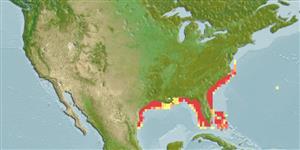Actinopterygii (ray-finned fishes) >
Scorpaeniformes (Scorpionfishes and flatheads) >
Triglidae (Searobins) > Prionotinae
Etymology: Prionotus: Greek, prion, -onos = saw + Greek, noton = back (Ref. 45335). More on author: Jordan, Gilbert.
Environment / Climate / Range
Ecology
Marine; demersal; depth range 1 - 45 m. Subtropical, preferred ?; 38°N - 24°N, 98°W - 59°W
Western Atlantic: Virginia to southern Florida in USA and northern and eastern Gulf of Mexico.
Size / Weight / Age
Maturity: Lm ? range ? - ? cm
Max length : 25.0 cm TL male/unsexed; (Ref. 7251)
Inhabits shallow-water bays.
Life cycle and mating behavior
Maturity | Reproduction | Spawning | Eggs | Fecundity | Larvae
Robins, C.R. and G.C. Ray, 1986. A field guide to Atlantic coast fishes of North America. Houghton Mifflin Company, Boston, U.S.A. 354 p. (Ref. 7251)
IUCN Red List Status (Ref. 115185)
CITES (Ref. 94142)
Not Evaluated
Threat to humans
Harmless
Human uses
More information
Age/Size
Growth
Length-weight
Length-length
Length-frequencies
Morphometrics
Morphology
Larvae
Larval dynamics
Recruitment
Abundance
ReferencesAquacultureAquaculture profileStrainsGeneticsAllele frequenciesHeritabilityDiseasesProcessingMass conversion
Tools
Special reports
Download XML
Internet sources
Estimates of some properties based on models
Phylogenetic diversity index (Ref.
82805): PD
50 = 0.5000 [Uniqueness, from 0.5 = low to 2.0 = high].
Bayesian length-weight: a=0.00389 (0.00180 - 0.00842), b=3.12 (2.94 - 3.30), in cm Total Length, based on all LWR estimates for this body shape (Ref.
93245).
Trophic Level (Ref.
69278): 3.4 ±0.3 se; Based on diet studies.
Resilience (Ref.
69278): Medium, minimum population doubling time 1.4 - 4.4 years (Preliminary K or Fecundity.).
Vulnerability (Ref.
59153): Low to moderate vulnerability (32 of 100) .
